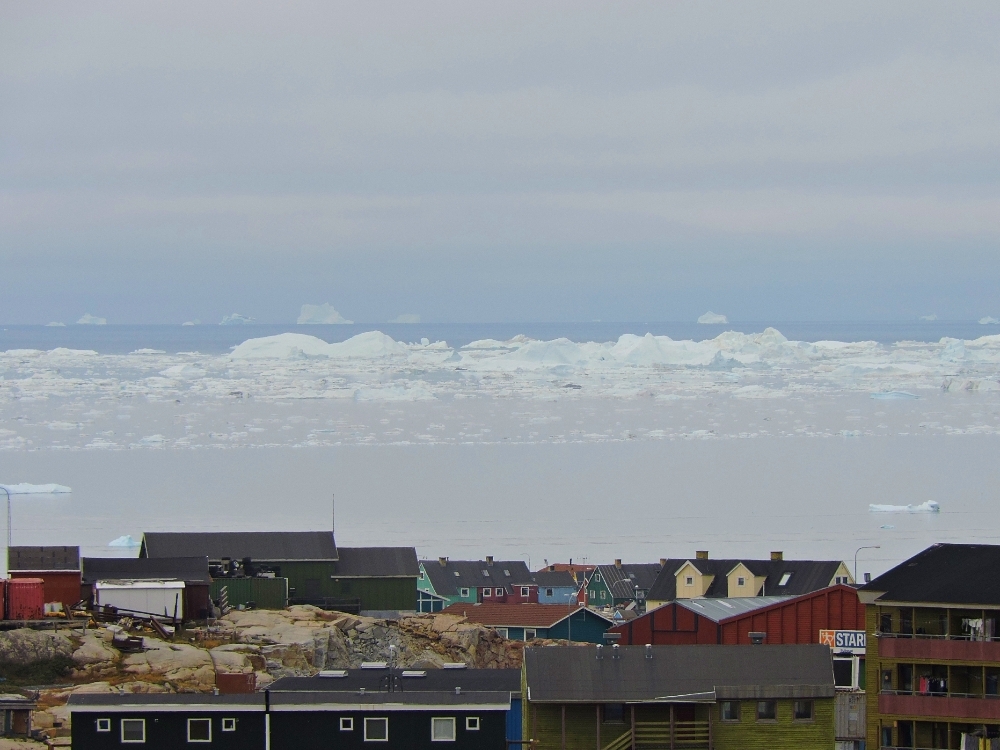I wanted to see Greenland. I wanted to see the Greenland Ice Sheet. I was interested to see how it is changing. All of these things are reasonable goals. The problem is that to achieve these tasks today essentially requires one to participate in the destruction of the very qualities that made that place interesting in the first place, not to mention the eventual ruination of the natural systems and human societies that have been in place on that large island for hundreds of years or more. Erik the Red and his settlers made their voyages to Greenland using only sail and human power, and, almost certainly, that seamed reasonable to them. In the modern age that we are so proud of, there are now no low-energy modes of transportation connecting Greenland, or most other populated places in the Arctic, for that matter, to the more temperate regions farther south. The only choices available now consist of the most carbon-intensive form of transport around, passenger jet services, and a few large-scale cruise ships, which are not far behind in terms of emissions.
On my long Tours, I have tried to minimize the use of any fueled transport as much as possible. Since that is a tremendously complicated thing to do at this point in time, I made it my policy to avoid long flights completely, and to use short flights, up to one or two hours long, only when no other options are available. Previously, that has sometimes been the case for political reasons, or more often, when the perplexing situation of islands without a marine transport connection have been involved. A visit to Greenland certainly exceeded that limitation. That fact was made even worse because there are currently no flights connecting mainland North America with the island. The shortest chain of flights possible today involves return trips through Iceland (or, even worse, Denmark), and the route following America>Iceland>Greenland>Iceland>America, results in almost thirty percent more flight distance, with a corresponding increase in carbon emissions, compared to a route of America>Iceland>Greenland>America. For the currently unavailable route of America>Greenland>America, the distance and emissions would have been almost half of the amounts for the required route today.
However, I did not hold true to my commitments, and let myself add this section to the Tour route, despite its implications. In the process, I personally emitted around one and a half thousand kilograms of carbon dioxide into the upper atmosphere, making a small, but not insignificant, contribution to the eventual collapse, and then disappearance, of the ice sheet that I went there to see. Even a small fraction of which would negatively impact coastal communities around the World, including the one in which I previously lived. I must become more unyielding in my efforts to curtail such massive emissions in the future.
With that being said, what did I see on the next section of the Tour in Greenland? In short, it was a segment that included one of the more unique cycling experiences I have yet been able to complete. There is essentially only one place in Greenland where it is possible to travel to the edge of the Ice Sheet overland in a reasonable length of time. Specifically, using Greenland’s longest road, which travels east from the airport village of Kangerlussuaq, eventually ending at the Ice Sheet. Some would say that this is Greenland’s only road, which is, more or less, correct. A guide on the ferry to Nuuk told me that it is a really long road,
but in reality the one-way distance is a fairly minimal 35.5 kilometers, though with an elevation gain of just over 500 meters. The surface is entirely gravel, so that could have meant trouble in such a remote area. Surprisingly, Google Street View has images of its entire length, and those seemed to indicate that its condition would make the ride feasible, however, another guide I spoke with was more disparaging about its condition. As usual, I didn’t give too much credence to the opinions of someone who wasn’t a cyclist, so I went ahead with my plans.
Those plans seemed reasonable to me, but, in fact, it was the type of itinerary that could easily fall apart due to any number of factors, from weather, delayed flights, road conditions, or mechanical problems with the bike. I would take a short 45-minute flight from Nuuk to Kangerlussuaq early on a Monday morning, then after reassembling the bike, having a meal, and buying some more food to carry along, I would ride up to the edge of the sheet in the afternoon. Tuesday, I would ride back to the airport in time to pack the bike again and catch another short flight to Ilulissat at 4:00 PM. In theory, if things weren’t going well, I could have used the entire 24-hour period to cover the 70-kilometer round trip, which seemed like it should have been plenty of time, even under the worst of circumstances.
As it turned out, the weather and other conditions were close to perfect, and everything went off without a hitch. The ride started on time on a beautiful day, when the temperature occasionally hit 25C. I would describe the road surface as medium
in quality as gravel roads go, with some loose rocks, an occasional bit of corrugation, and a few sections with deep sand, but overall the pace that was possible was reasonable enough. Since Kangerlussuaq is at the end of a long fjord, the road first ran along the river that feeds into it, and its characteristic milky gray-green appearance belied the fact that a glacier lay beyond.
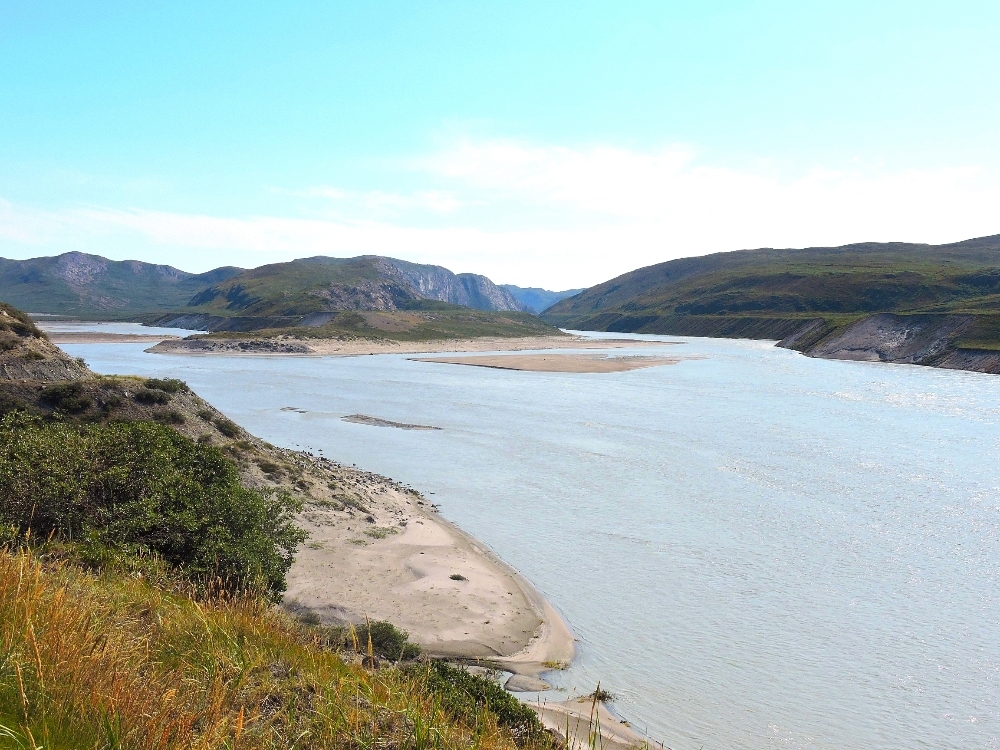
Some sections with swiftly flowing currents also revealed that the elevation was slowly increasing.
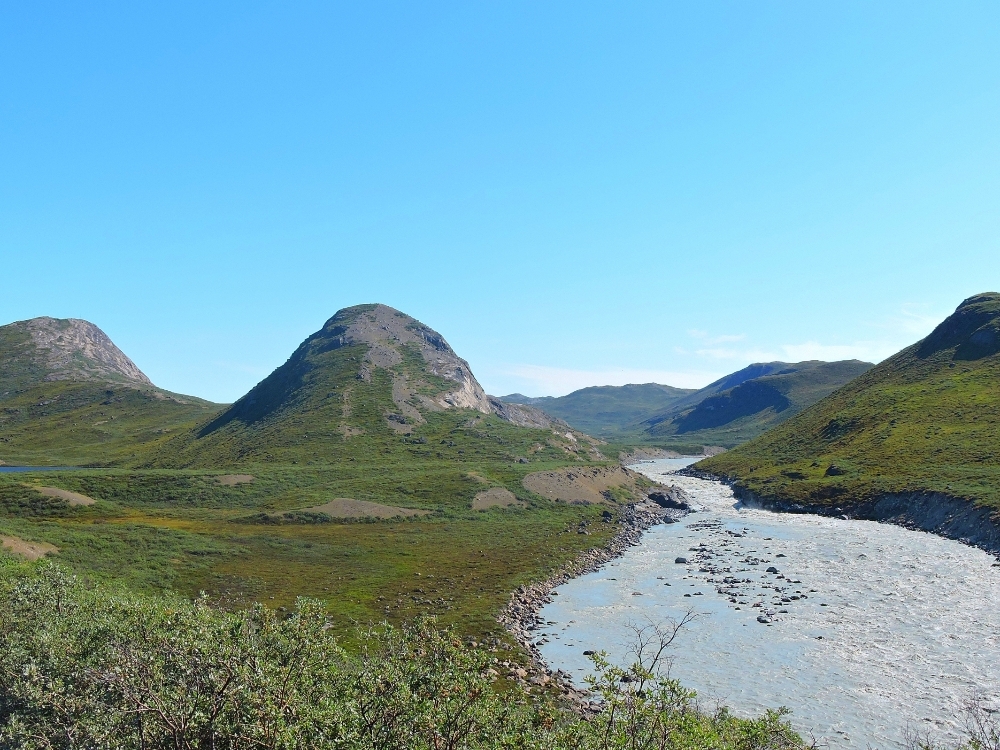
The scenes along the way were always impressive.
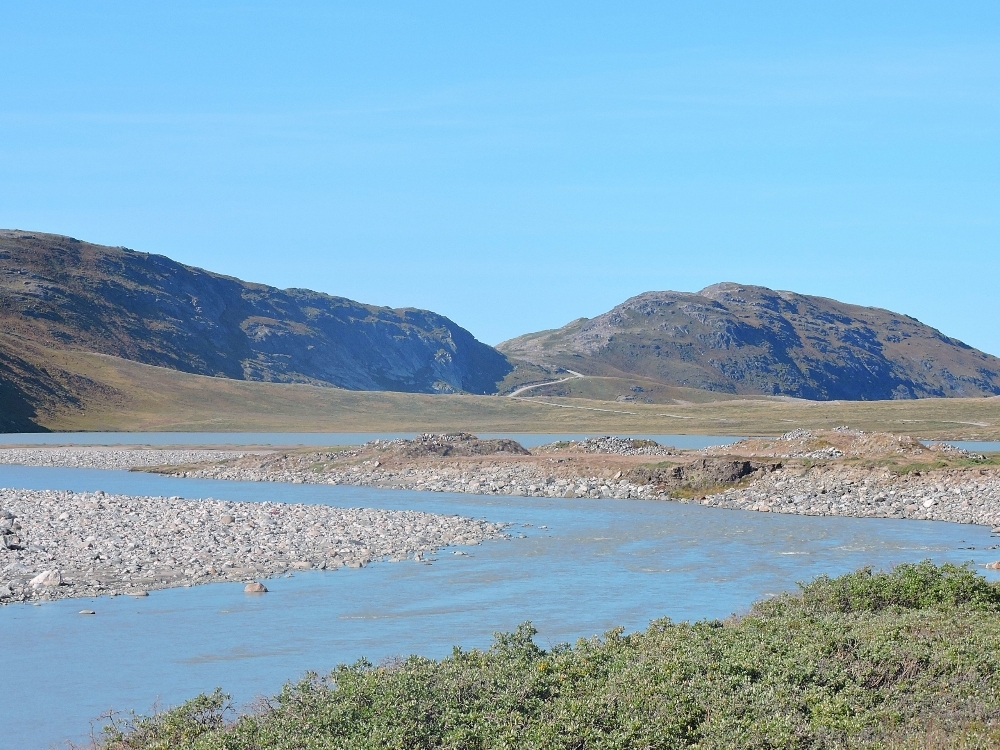
After about 20 kilometers the road passed the Russell Glacier, not yet the main Ice Sheet, but a more quickly flowing tongue
of ice protruding towards the west.
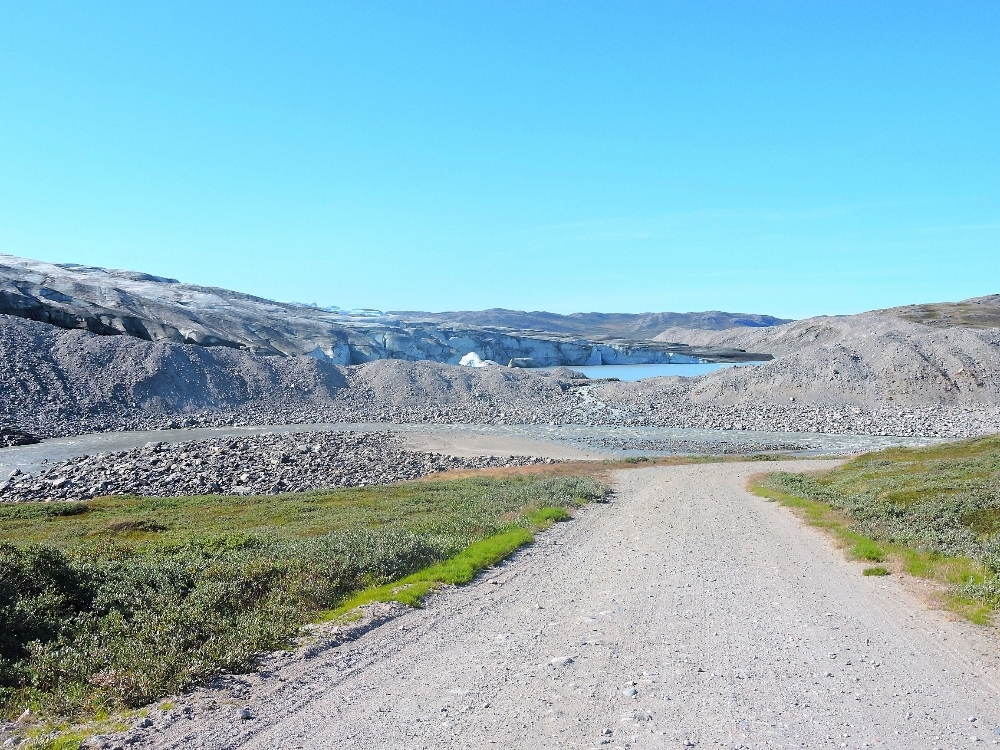
It took quite some time to completely move past that immense feature. After then, the condition of the road slowly began to deteriorate, with occasional steep sections littered with loose rocks.
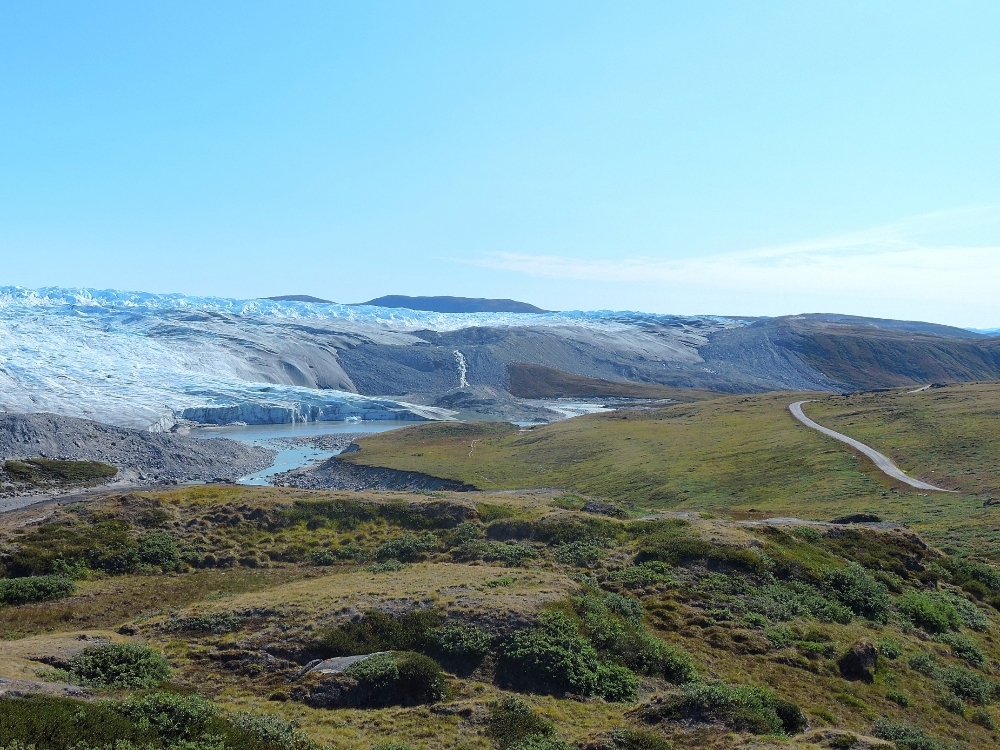
It was in this area that I had one of the nicest wildlife encounters I have had for quite some time, specifically, meeting a family of Muskox. That species is poorly named, since they are not closely related to Oxen at all, but are more like very large, shaggy goats. Like most goats, their temperament is said to be nervous and unpredictable, and tourists are advised to keep a wide distance from any that they may come across. In this case that was impossible, as a group of five, one cow and four younger individuals, happened to be standing behind a big pile of gravel along the roadside. As I rode along, none of us could see each other until we were separated by just fifteen to twenty meters. They saw me first, and appeared startled. I came to a stop and behaved as one should, calmly, without making any sudden moves. The mother snorted at me once, and then the group moved back into the grass just beyond the road. I took just enough time to get a few quick photos, then made some non-threatening Chhh…Chhh…Chhhh
sounds, and at that point the group took off, dashing up the hill away from the road.
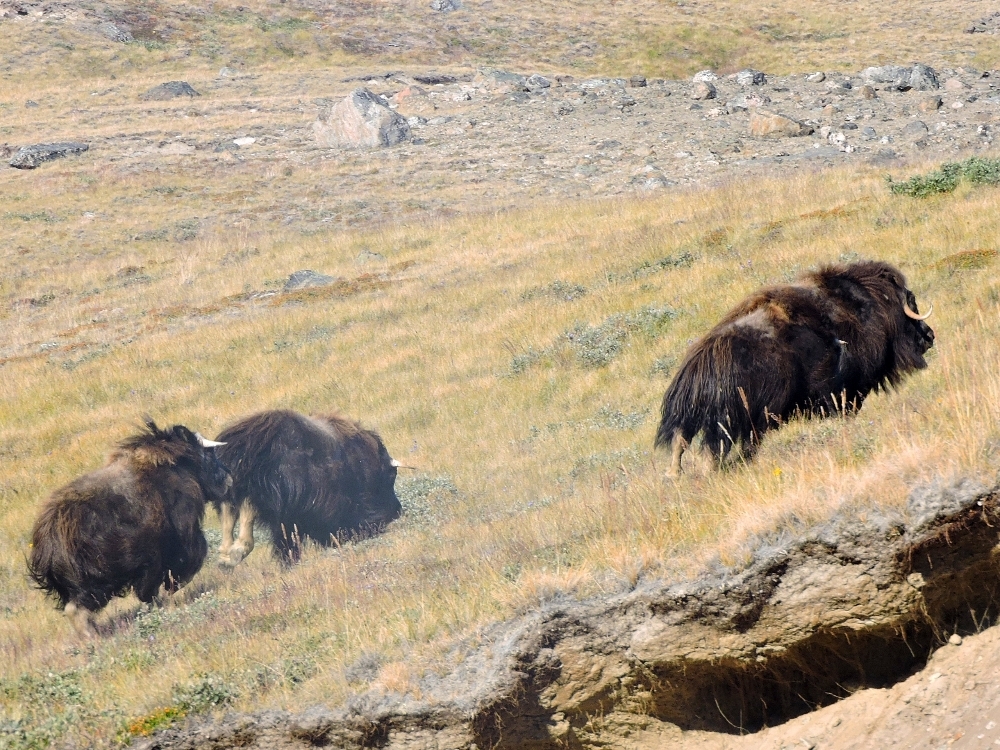
They were heading up to join the bull of the group, who had been watching from his post on a hilltop above the road, appearing fairly disinterested in the whole event.
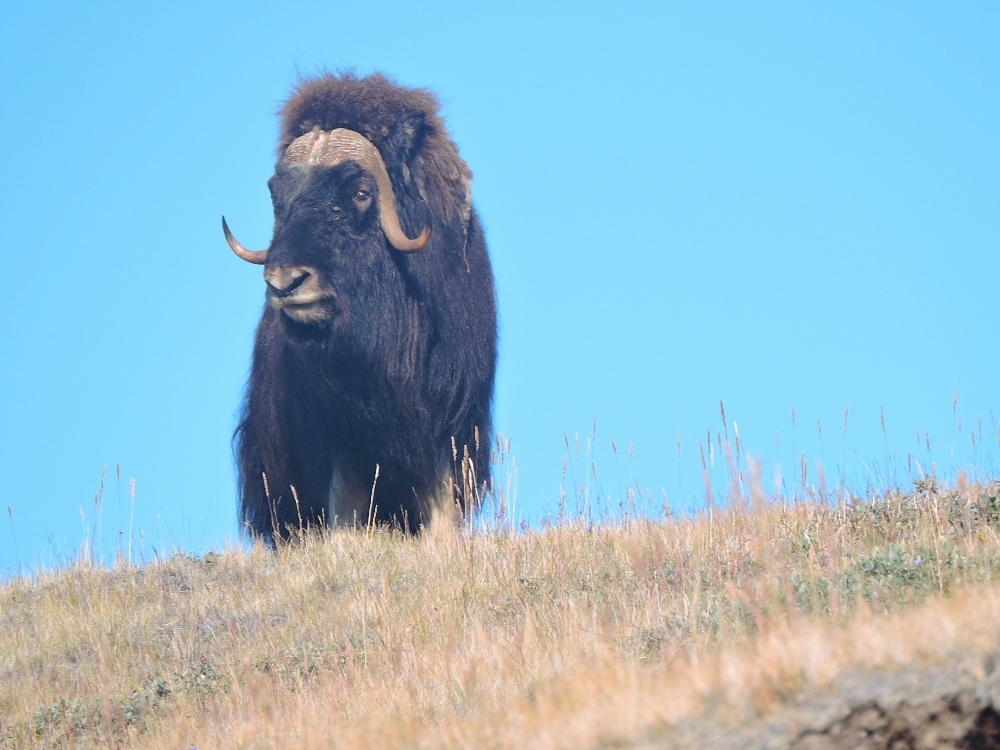
After several short sections of steeper grades, most in fairly poor condition, the end of the road is reached, and the massive main body of the Greenland Ice Sheet then dominates the view. Its appearance is more impressive than what is shown in this image. The gray moraine in the foreground is actually hills of rubble twenty to thirty meters high, and the ice beyond stretches out across the entire field of view. If it were possible to ride due east from that point, (if there was a smooth surface, as well as periodic places to obtain food,) it would be another 700 kilometers before the eastern edge was reached. At the normal pace for this Tour, that would me take around five and a half days of cycling. Of course, that is impossible, because the Ice Sheet is actually one of the most inhospitable places on Earth.
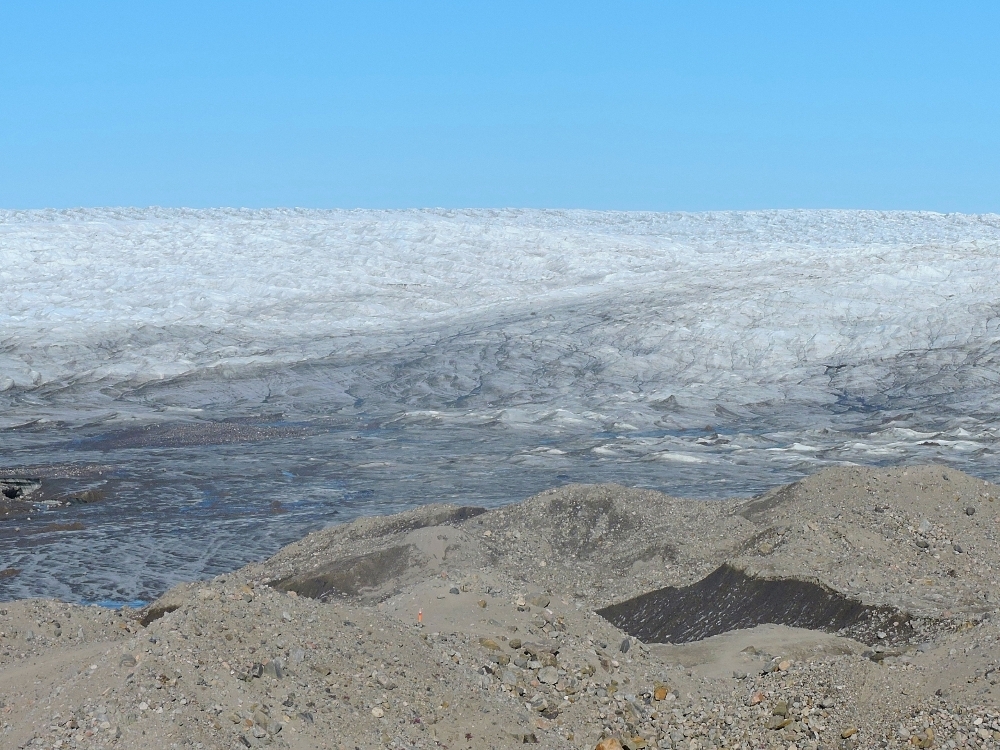
It is possible to—very carefully—walk over the moraine and out onto the thinner edge of the sheet itself. Despite being on ice, on that day the temperature there was cooler, but still fairly pleasant. In some places the ice is pristine white in appearance, while elsewhere it is darkened by pulverized rock dust.
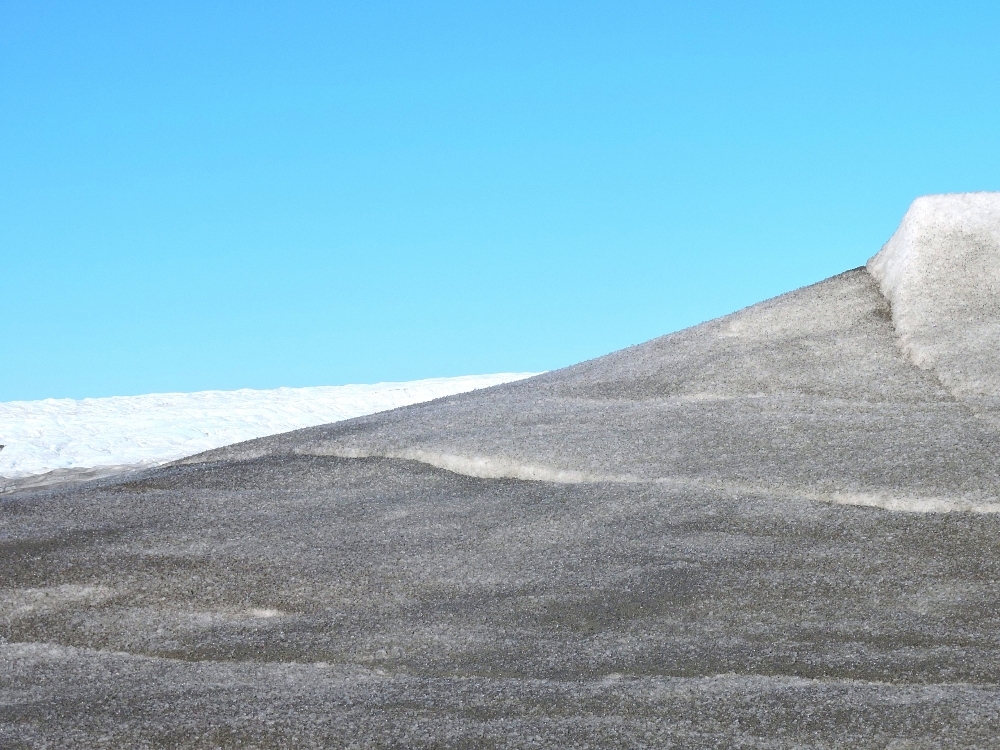
The only noise one hears on a still day is the rushing of streams of meltwater gushing across the surface of the ice.
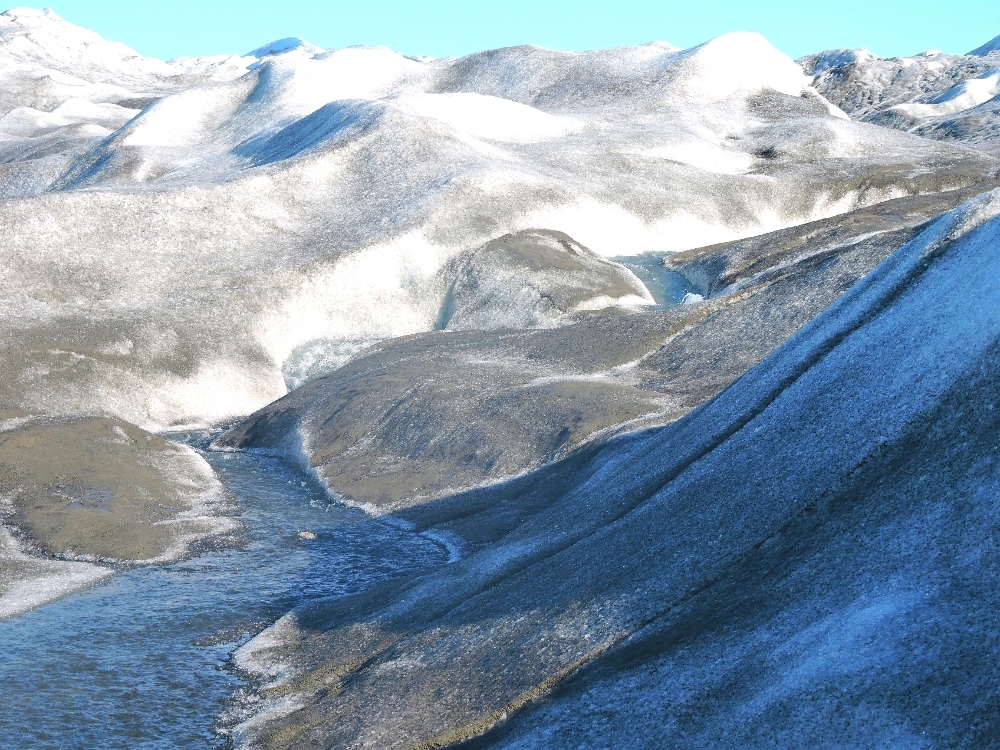
As I arrived, a group of researchers from Rutgers University were packing up their equipment to head back to town. We chatted about their work for a few moments, which involves measuring the amount of melting occurring, and their opinion was that this would be a big year for ice loss.
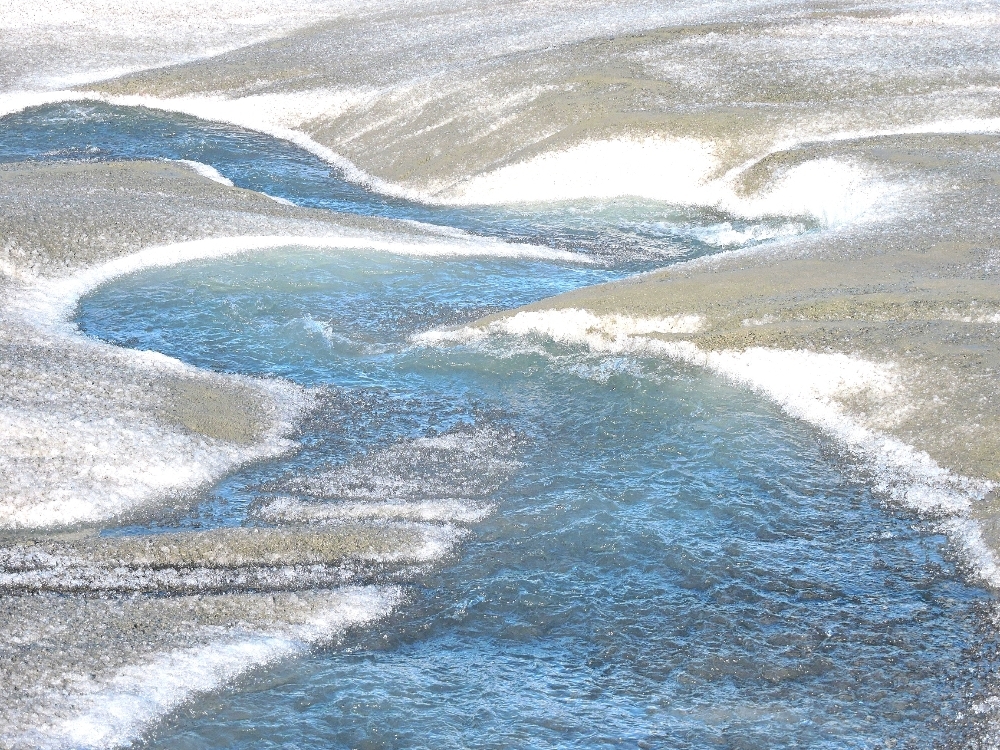
It took me just four hours to reach the end of the longest road in the country, at the edge of the massive sheet of ice, and so I had no reason to rush back to Kangerlussuaq. Instead, I took a nice rest and perhaps got a few hours of sleep during the dusky light of the hours past midnight. Camping in view of the massive slab of ice is an experience that I won’t soon forget. The ride back the following day, just slightly faster with a descent on a rough road, was rather pleasant, and the different angle of the morning Sun illuminated the ice in a varying ways, making it appear as a route I hadn’t seen before.
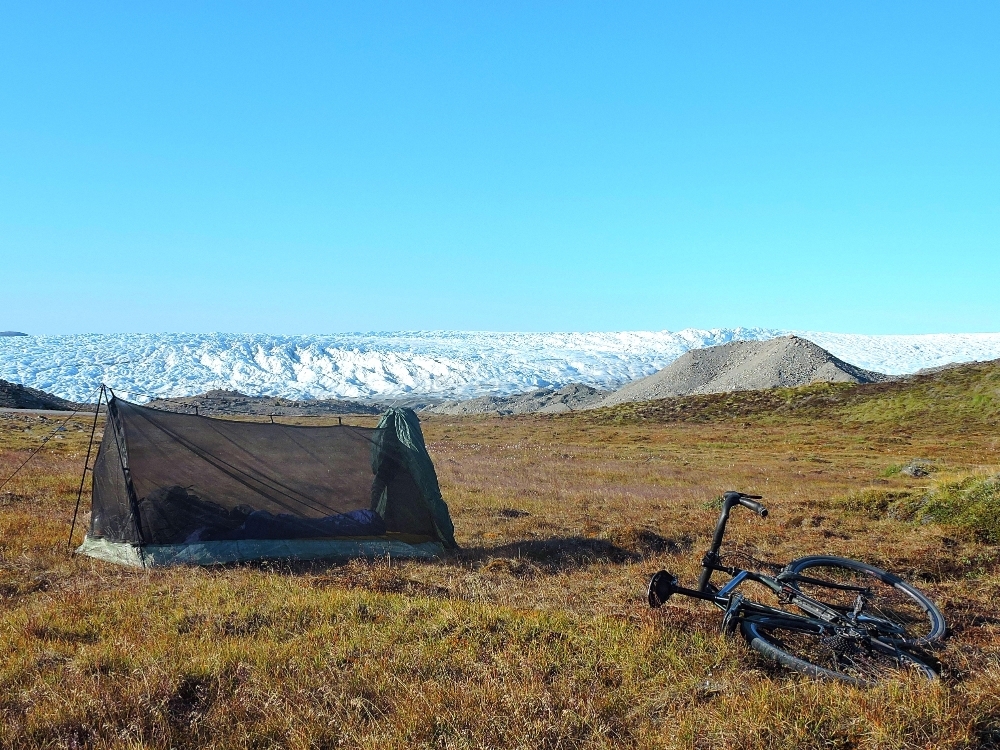
My last stop in Greenland was Ilulissat, another roadless town. While it is possible to get there by sea from Nuuk, aboard the Sarfaq Ittuk, from Kangerlussuaq another short flight was required. The ice there has its own post in the World Heritage section, but here I will mention one or two aspects of the town itself. With a population of around 5,000 inhabitants, it is Greenland’s third largest town, and at 66 degrees north latitude, it, unsurprisingly, has a more polar feel than the towns of the south. However, with a fairly large tourist presence in the summer, services are surprisingly adequate.
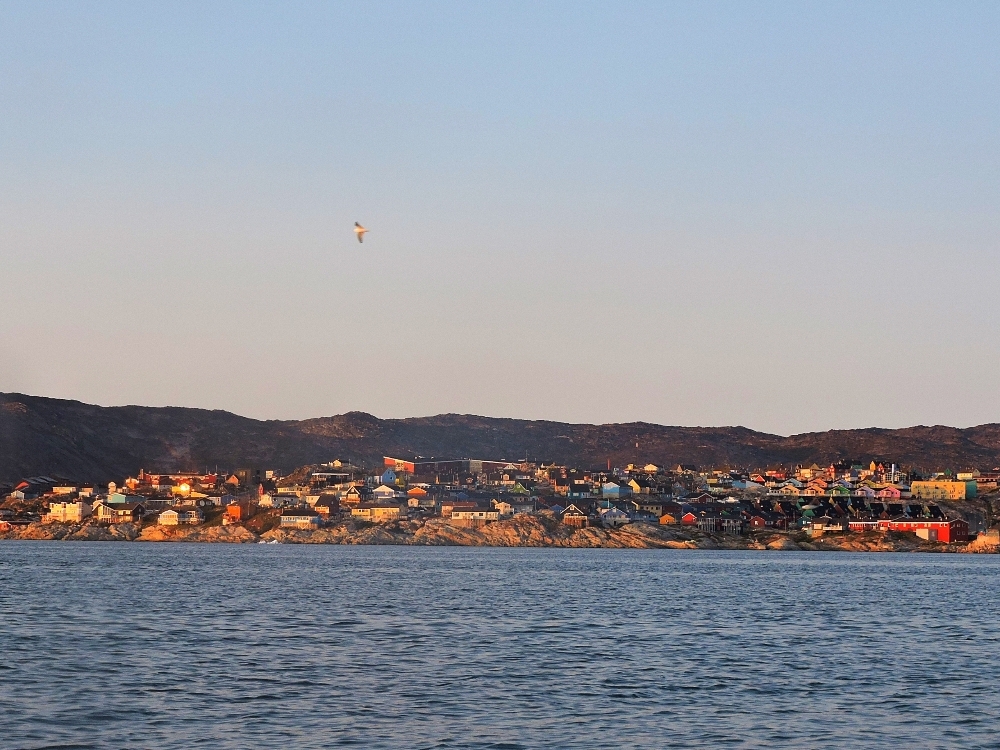
The geography of the settlement leads to one of its more unique features. Between the neighborhoods, which are usually on hillsides, are shallow ravines and plains that are both rocky and marshy, making them unsuitable for buildings. Instead, these areas are used as summer quarters for the many sled dogs, numbering around 2,000, that provide transportation for the town in the snowy winter months. During the long days of summer they spend their time alternating between sleeping and howling. This interesting situation was the type of scene I expected to see in Greenland, as opposed to the Chihuahuas of Qaqortoq.
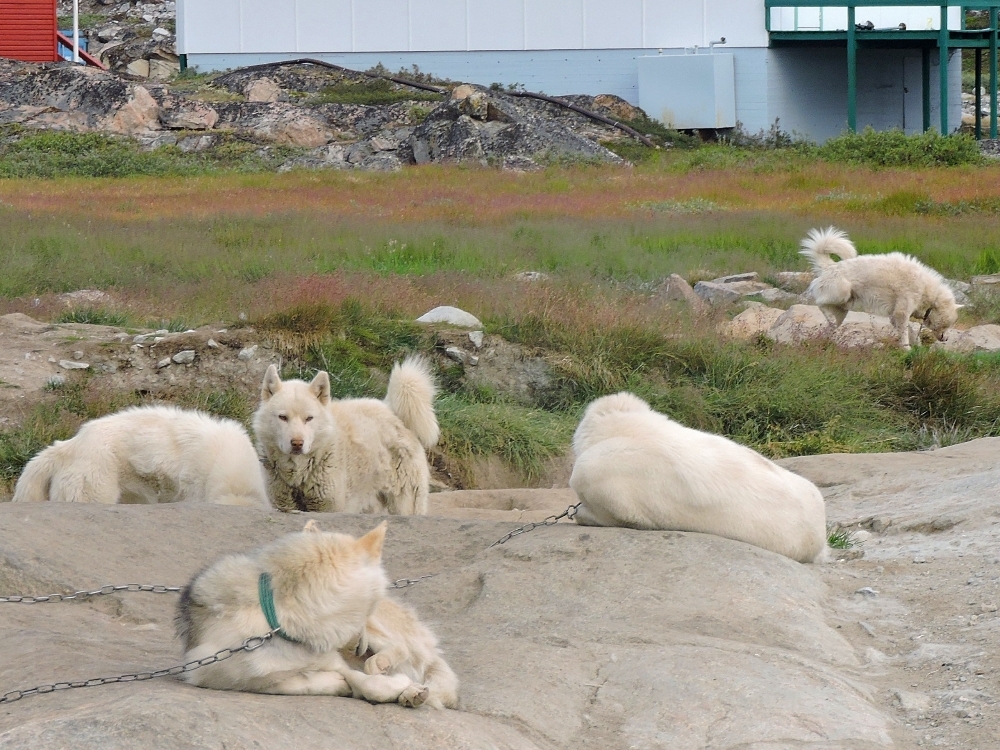
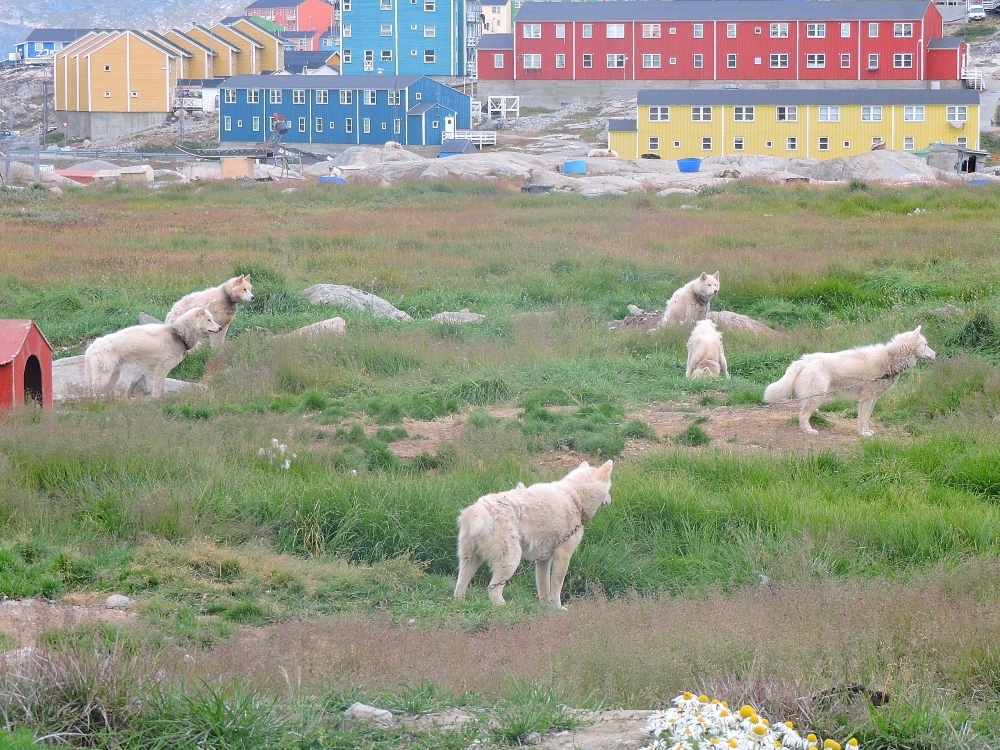
Another typical scene was observed from the hillside apartment I stayed in, which had a beautiful view of the ice slowly drifting out into Disko Bay. If scenes like that are to endure for long, it now seems obvious that the way our society operates needs to be completely redesigned—from scratch. It would be nice if people actually began talking about that in a serious way at some point.
